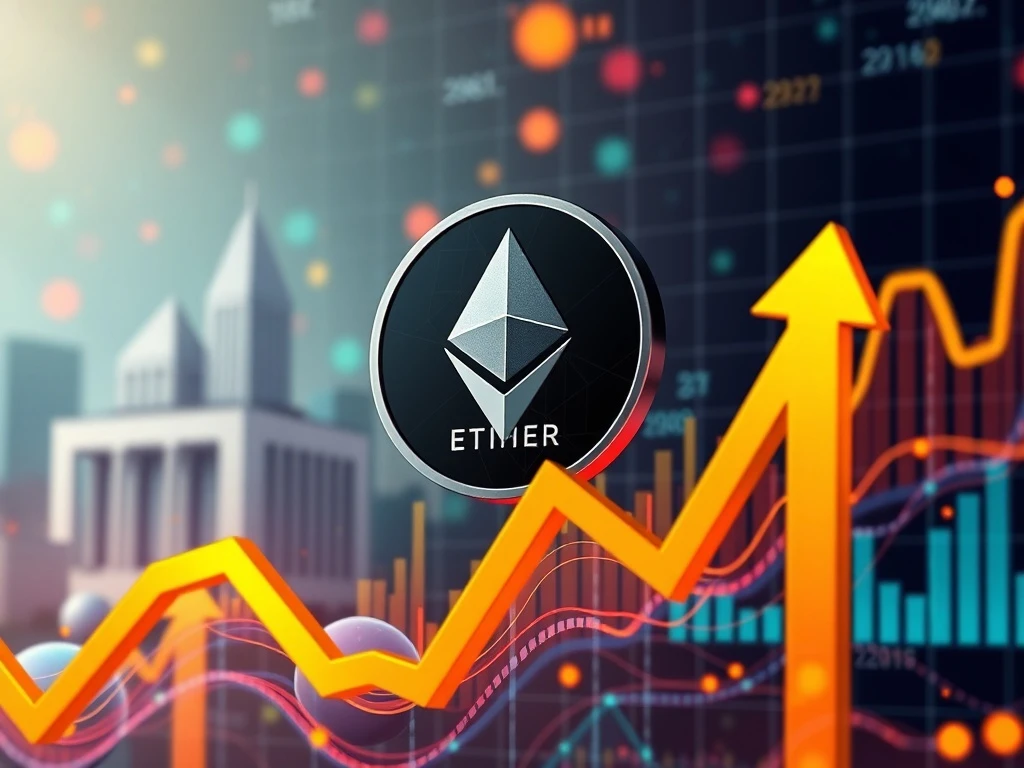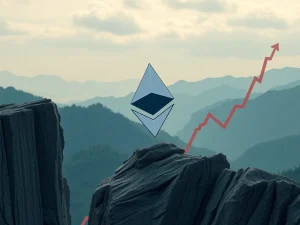Unleashing Potential: Ether ETF Inflows Reshape Crypto Trading in 2025

The cryptocurrency market witnessed a remarkable shift in August 2025. Specifically, Ether ETF inflows surged dramatically, signaling a new era for digital asset investments. While Bitcoin ETFs experienced outflows, Ether (ETH) attracted billions, capturing significant institutional interest. This divergence highlights Ether’s growing utility and its expanding role in mainstream finance. Consequently, traders are closely monitoring these developments for potential market movements.
Understanding Ether ETF Inflows: A New Era for Crypto Traders
Ether has always offered more than just a digital store of value. As the foundational layer for decentralized finance (DeFi), non-fungible tokens (NFTs), and smart contracts, its real-world applications are extensive. In 2025, Ether solidified its position further. The introduction of spot Ether ETFs provided institutional investors with a regulated and accessible gateway to ETH exposure. Indeed, the narrative has expanded beyond just Bitcoin ETFs.
Data from SoSoValue revealed a compelling trend in August 2025. Ether ETF inflows reached an impressive $3.87 billion. Conversely, Bitcoin ETFs saw $751 million in net outflows during the same period. This striking difference has reignited discussions about “the flippening,” where Ether might eventually challenge Bitcoin’s market dominance. For discerning traders, this momentum offers a crucial signal. ETF inflows often precede significant price movements, making this trend particularly noteworthy.
The Mechanics of Spot Ether ETFs: What You Need to Know
Before diving deeper into the implications, understanding spot Ether ETFs is essential. These funds trade on traditional stock exchanges. They allow investors to gain exposure to ETH without directly purchasing or storing the cryptocurrency. Currently, Ether ETFs hold approximately $28 billion in assets. This represents about 5% of ETH’s total market capitalization.
Here’s a breakdown of key concepts:
- What it is: An Ether ETF is a financial product. It tracks ETH’s price, offering indirect investment.
- Spot vs. Futures: Spot ETFs hold actual Ether. Futures ETFs, however, track ETH futures contracts.
- Inflows: These represent the net capital entering the ETFs. Positive inflows indicate strong demand and confidence. Outflows, on the other hand, suggest selling pressure.
Recent data from late August/early September 2025 underscores the market’s growing importance:
- BlackRock’s ETHA ETF commands roughly $16 billion in net assets.
- Grayscale’s ETHE manages approximately $4.6 billion.
- Fidelity’s FETH holds around $3.5 billion.
Combined, Ether ETFs account for approximately $28.8 billion. This figure signifies a notable milestone for mainstream adoption. While Bitcoin ETFs remain larger, momentum clearly favors Ether. For example, BlackRock’s IBIT leads Bitcoin ETFs with about $82 billion. Nevertheless, the accelerating inflows into Ether products suggest a significant shift in investor focus.
Why ETH Price Reacts: Inflows as a Market Signal
Ether ETF inflows are more than mere statistics. They function as critical market signals, revealing institutional investors’ strategic positioning. Traders should monitor these numbers closely. They frequently align with shifts in price trends and liquidity.
Consider why these inflows matter for your cryptocurrency trading strategies:
- Institutional Sentiment: Rising inflows demonstrate that hedge funds, pension funds, and asset managers are increasingly confident in ETH’s future. This signals a broader acceptance.
- Liquidity Dynamics: Greater ETF demand typically pulls ETH off exchanges. This action reduces the available supply, which can consequently push prices upward.
- Historical Parallels: In 2021, crypto ETFs amassed around $7.6 billion in net inflows. This contributed significantly to Bitcoin’s rally to fresh all-time highs. Such precedents provide valuable context.
A recent example clearly illustrates this dynamic. On July 16, 2025, Ether ETFs recorded a record-breaking $726.6 million in single-day inflows. This event coincided with ETH testing the $5,000 level before a slight pullback. Furthermore, in late August 2025, US spot Ether ETFs logged their second-largest daily inflows ever at $729 million. Just days earlier, they set a new record of $1.02 billion. Over three days, cumulative inflows surged to a new peak of $12.1 billion. During this period, ETH neared its all-time high. Traders can gain early insights by monitoring platforms like SoSoValue, CoinShares, and Farside Investors. These resources track whether institutional flows are accelerating or slowing.
Navigating Cryptocurrency Trading with ETF Data
Ether ETF inflows can profoundly influence short-term price action. As billions flow into these ETFs, the available ETH supply on exchanges often decreases. This creates upward price pressure. However, it can also fuel volatility when markets overreact.
Short-term impacts for active traders include:
- Price Momentum: Inflows frequently generate price surges as demand spikes. ETH rising over 40% in July 2025 serves as a prime example.
- Volatility: ETH dropped 4% in 24 hours after failing to hold $5,000, despite strong inflows. Traders must therefore prepare for potential pullbacks.
- Options Market Impact: Increasing inflows can elevate implied volatility. This creates lucrative opportunities for options sellers to capture premium.
- Arbitrage Potential: Price discrepancies between ETF shares and ETH spot markets can be exploited. Sophisticated traders often leverage these gaps.
Effective cryptocurrency trading strategies to monitor include:
- Implementing momentum trading during periods of significant inflow surges.
- Hedging exposure using futures or options when inflows reach their peak.
- Watching ETH reserves on exchanges. This provides an early warning system for potential price squeezes.
Short-term traders can certainly profit from volatility. However, they must maintain strict discipline with risk management. Sudden reversals are common in dynamic crypto markets. Notably, Ether hit a new all-time high of $4,945 in August 2025. This surpassed its November 2021 record of $4,878, largely fueled by fresh institutional momentum.
The Future of Institutional Adoption: Ether’s Long-Term Trajectory
Beyond short-term volatility, the ascent of spot Ether ETFs signals deeper institutional adoption. This trend holds significant implications for long-term stability, liquidity, and ETH’s eventual role as a global financial asset. Corporate treasury adoption, for instance, is steadily growing.
Consider these notable examples:
- SharpLink Gaming added over 800,000 ETH to its balance sheet this year.
- ETHZilla increased its reserves to more than 102,000 ETH.
- BitMine Immersion Tech now holds over 1.8 million ETH. This makes it the largest publicly traded ETH holder.
Furthermore, institutional sentiment is clearly shifting. VanEck CEO Jan van Eck famously called ETH “the Wall Street token.” He emphasized its critical role in stablecoin transfers and broader financial infrastructure. ETH ETFs now represent over 5% of total ETH market capitalization. This marks a substantial milestone for mainstream acceptance.
Potential long-term benefits for Ether include:
- Greater liquidity and reduced volatility as ETF participation deepens.
- New demand streams from pension funds, family offices, and insurance companies.
- Increased integration of ETH into traditional financial systems. This is especially likely if staking features are approved for ETFs by the end of 2025.
Ether’s utility extends beyond merely being a store of value. Its integral role in DeFi and enterprise applications makes it an increasingly attractive long-term institutional asset.
Key Risks and Challenges for Ether Traders
Despite the impressive growth of Ether ETF inflows, traders must remain cautious. Several inherent risks could impact the market in the near term. These challenges affect both retail and institutional participants.
1. Regulatory Uncertainty
US lawmakers have introduced measures such as the GENIUS Act and CLARITY Act. These represent steps toward clearer crypto regulations. However, the regulatory landscape remains unpredictable. The US Securities and Exchange Commission (SEC) could quickly alter its stance. New restrictions on ETF approvals, staking features, or compliance requirements could diminish institutional demand. This uncertainty requires careful monitoring.
2. Competition with Bitcoin ETFs
Bitcoin ETFs still dominate the market, boasting over $100 billion in assets. BlackRock’s IBIT leads this segment with approximately $82 billion. While ETH ETFs are gaining significant traction, Ether must sustain these inflows. This will prove its long-term staying power. Traders should remember that Bitcoin continues as the benchmark institutional asset. This might limit ETH’s independent momentum.
3. Over-reliance on ETF Data
Strong inflows often create bullish narratives. However, heavy outflows can just as easily trigger sharp declines. Traders should avoid basing decisions solely on ETF data. Instead, consider other crucial signals. These include exchange reserves, technical analysis, and broader macroeconomic conditions. A diversified approach reduces the risk of being caught off guard by sudden market reversals.
4. Volatility in Early Phases
Like Bitcoin ETFs in their initial years, Ether ETFs are still relatively new. This newness may introduce heightened volatility. Price swings of 10% or more are possible, even in response to modest news events. Traders must employ robust risk management strategies. These include stop-loss orders, proper position sizing, and effective hedging. Such measures are vital to navigate this early-phase turbulence successfully.
Conclusion
The substantial Ether ETF inflows in August 2025 underscore a pivotal moment for the cryptocurrency market. These inflows highlight Ether’s expanding utility and its increasing appeal to institutional investors. While offering significant opportunities for cryptocurrency trading, particularly in the short term, traders must also acknowledge the inherent risks. Regulatory shifts, competition, and market volatility remain critical factors. Ultimately, a balanced perspective, combining ETF data with broader market analysis, will be essential for navigating Ether’s evolving trajectory in the financial landscape.








